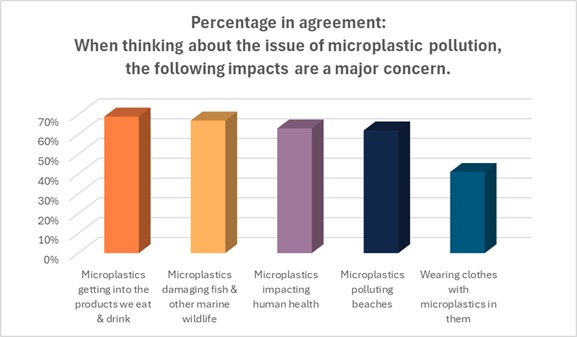The hazy days of summer are here and so is Plastic Free July. The global movement is a key initiative of the Plastic Free Foundation, whose vision is to see “a world free of plastic waste.” For those in the fashion industry, it marks an opportune time to take stock of the fibers and textiles used to make today’s clothing – and reach for plastic-free options. This means choosing fibers other than petroleum-based synthetics like polyester, nylon, and acrylic.
As a general rule…as one of the easiest things we can do, whether it’s a water bottle or fast fashion, is avoid single-use products.
Christopher Reddy, senior scientist, Department of Marine Chemistry and Geochemistry, Woods Hole Oceanographic Institution
“All things considered equally, you would want to look to products that have been known for a while, that we have a very good understanding of the history of using them,” said Christopher Reddy, senior scientist in the Department of Marine Chemistry and Geochemistry at the Woods Hole Oceanographic Institution, in an interview with the Lifestyle Monitor™. “With cotton, we have a very good knowledge about how cotton products are made, how much energy is used to make them. The data shows cotton is biodegradable and would break down faster [than petroleum-based fibers]. We have a sound understanding. And we have a very good understanding about how cotton behaves.”
“We have a long history of making things of cotton and denim,” Reddy continued, “and we don’t see any detrimental effects. And we do know cotton materials break down relatively quickly. With cotton, we don’t see the types of problems that we see with the more manmade products.”
In 2023, virgin fossil-based synthetic fibers (including polyester) accounted for about 57 percent of global fiber production, while cotton made up roughly 20 percent, making it the most widely used natural fiber globally. Unless a sea change occurs, it is predicted that synthetic fibers will continue to dominate, likely accounting for up to three-quarters of all fiber use by 2030. A study by the International Union for Conservation of Nature (IUCN) found that synthetic apparel and textiles account for the largest percentage of microplastic in the world’s oceans (35 percent). Studies also show microplastic fibers accumulate in soil.
The World Economic Forum released an article stating microplastics have been detected throughout the human body, including lungs, lower limb joints, and the human brain. Studies are being conducted to understand the impact of microplastics on human health.
The study of microplastics is relatively new, as Science reports that the term was only first used to describe microscopic fragments of plastic debris in a publication in 2004. But consumers are becoming more aware – and more concerned – about them. Consider that 7 in 10 consumers are either somewhat (41 percent) or very (33 percent) aware of microplastic pollution, according to the Cotton Incorporated 2025 Microplastics Survey. Among those who are aware, 58 percent are very concerned about microplastic pollution.
According to the 2025 Microplastics Survey, consumers are concerned about the impacts of microplastic pollution. For example, nearly 7 in 10 (69 percent) worry about microplastic fibers getting into the products they eat and drink. And a similar number (67 percent) are concerned that microplastics are damaging fish and other marine life.

Of note for fashion brands: Among consumers that are aware of microplastic pollution, 70 percent know it comes from clothing made of synthetic fibers during washing, according to the Cotton Incorporated 2025 Lifestyle Monitor™ Survey. And 3 in 10 shoppers (30 percent) say they are bothered that brands and retailers are using synthetic fibers in their clothing. Further, the majority of consumers (71 percent) say they are likely to check the fiber content label before purchasing a clothing item to avoid apparel made from synthetic fibers.
To give consumers options other than petroleum-based fibers like polyester, brands could offer more natural fibers like cotton in their offerings. Cotton’s key benefits speak to a number of consumer concerns. For instance, cotton is naturally biodegradable, with cotton fibers breaking down in months, as opposed to a much longer time period for synthetic fibers, according to a review article from North Carolina State University. And while dyes and finishes can slow the degradation process, cotton still “vastly outpaces” synthetics in returning to the earth, according to a study reported in the Marine Pollution Bulletin.
Cotton so easily biodegrades because it is a cellulose fiber. Cellulose is a natural polymer that forms the main structural component of cotton fibers and other plant-based materials. It’s also the factor that gives cotton its strength and durability.
Wait, super durable yet it breaks down easily? The science-inclined can check out “Biodegradability of Cellulose Fibers, Films, and Particles: A Review,” which details how specialized enzymes primarily produced by bacteria and fungi in the environment are the key catalysts for cotton’s natural biodegradation. These enzymes basically “unlock” the cellulose structure, breaking it down into simpler components that can be utilized in the ecosystem.
So, while cotton apparel also sheds microfibers, these tiny particles biodegrade much faster than fibers from fossil fuel-based garments whether on land or in water, according to studies performed by Cornell University, Duke University, and North Carolina State University.
As part of Plastic Free July, the organizers ask participants to make a pledge to refuse single-use plastics. As that relates to the garment industry, fast fashion blossomed through its reliance on very inexpensive clothing made from synthetics that – while not necessarily single use – aren’t generally worn more than a few times. Yet, the way they’re produced from extruded petroleum and their lasting effects on health and the environment raise questions among consumers, conservationists and scientists.
“There are materials that were made and released into the environment, right?” Reddy said. “And you ask, ‘Where are they, how long are they going to last, what type of harm could they pose?’ We don’t know. But what we do know is that we don’t want that. All the knowledge we have is just scraping the surface. And when you think about single-use fashion, you’re using energy to make it from crude oil carbon. You’re using water to manufacture it. Then there’s energy and water to deliver it. And for what? Something that’s worn once. It’s problematic.
“As a general rule,” Reddy stated, “as one of the easiest things we can do, whether it’s a water bottle or fast fashion, is avoid single-use products.”
